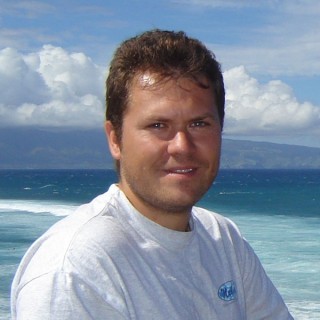We know that Loihi Seamount is affected by hydrothermal activity that can lead to giant plumes of rusty flecks in the water column and at the seafloor. Those marine particles form when hydrothermal iron is oxidized either by microorganisms (the “iron eaters” that poop rust) or by small amounts of oxygen dissolved in the deep ocean. Iron-rich particles, together with dissolved chemical species such as ferrous iron and manganese are then swept away with ocean currents, leading to a so-called “hydrothermal plume” that can be tracked many miles away.
CTD: The Plume Sniffer and Sampler

Yesterday, we recovered our first water samples from Loihi’s “rusty” hydrothermal plume. The Falkor crew deployed the CTD rosette down to 1300 meters depth, right into Pele’s Pit, a 300 meter-wide crater at the summit of Loihi Seamount. The shipboard rosette is equipped with 24 -12 liter bottles, also called “Niskin bottles” that are used to collect seawater samples. As the rosette is lowered into the ocean, water flows freely through the open end of the bottles as if they were pipes. Seawater is then captured by instantaneously closing stoppers at each end of the bottle. The CTD rosette also features fancy sensors measuring important oceanographic parameters such as salinity, temperature and density. Other specialized sensors have also been added for this research in order to sniff hydrothermal plume materials by measuring the activity of hydrogen ions (pH) and electrons (Eh). This will help us to know how corrosive the seawater is and how much stuff is floating in it.
Sampling Frenzy


Once the CTD rosette is safely back onboard, the sampling frenzy ensues with the science party ferociously beginning to collect the water samples for analysis. This is actually a quite organized and careful process; first, each bottle is checked to make sure that it worked and that there are no signs of leaks. Then, scientists fill a wide variety of plastic vials and bottles; each bottle is rinsed with the water sample several times prior to being filled. This results in a lot of water all over the place, even into our shoes! We also recover particles after filtration of the Niskin bottles using a very fine mesh. Some of these samples will be used for shipboard measurements, but most of them will be safely stored, packed, and shipped back to the lab for analysis after the cruise.
Shades of Purple – You got Iron!

Even for an experienced team, sampling ocean waters is never an easy task, especially for trace metal analysis. Potential source of metal contamination is everywhere on a ship (think about all that rust) and getting contamination of iron as low as 1/1,000,000 grams per liter of seawater would definitively ruin our sample. Luckily, we have protocols to protect the samples and today, we have already started generating iron concentration in the wet lab. We use a so-called “ferrozine method” to obtain iron concentrations from the water. Ferrozine is a chemical agent (with the following formula for chemistry geeks (3-(2-Pyridyl)-5,6-Bis(4-Phenylsulfonic Acid)-1,2,4-Triazine) that gives a pretty purple color in the presence of iron. The intensity of this color is measured using our shipboard spectrophotometer which gives us an idea of how much iron is in our sample. Our first results not only confirmed that Loihi is still continuously blowing lots of iron in seawater, but also allowed us to locate precisely the depth where the hydrothermal plume is most intense. This information will be precious in the coming days for planning CTD sampling.

Once onshore, we will measure the concentration of many chemical species in the seawater using mass spectrometers, and perform isotope analysis of iron, chromium, nickel and germanium. Measuring the natural abundances of metal isotopes at Loihi Seamount will undoubtedly provide new views of the biogeochemical cycling of metals in hydrothermal plumes and their fate in the ocean. Thanks to the Falkorcrew and SOI, we are already getting exciting seawater samples that will ultimately quench our thirst for the coming months.

